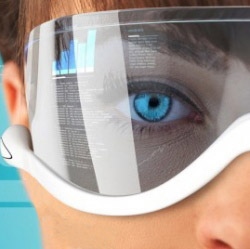
f you’ve ever been to a theme park or arcade that offered any virtual reality games, you probably noticed that they were mostly terrible. A lot of the VR headsets give the effect of having a small TV inches from your face along with glitchy, headache-inducing graphics that would have looked out of date a decade ago. It doesn’t make for an immersive experience, especially when compared to the near-photorealistic graphics you can get from today’s consoles and PCs. The only quality VR setups out there are usually reserved for military or scientific simulations and carry price tags starting at about $100,000 – not exactly the sort of thing you’d get for your living room. A company called Oculus is hoping to change all that with the Rift, a VR headset built with the latest technology and designed for consumers.
The Rift straps onto a person’s face like a pair of goggles and immerses them with a stereoscopic 3D display. The display allows for a field of view of 110 degrees diagonally, compared to most VR displays that only reach up to about 40 degrees. This makes all the difference between seeing a game played on a screen in front of you and having it surrounding your vision almost entirely. The current developer kit has a resolution of 720p (1280×800), but will be improved for the consumer version.
Most VR headsets are plagued by latency issues as well, causing a noticeable delay between when a person moves their head and when the screen adjusts follow along. Oculus has tackled that problem by adding real-time head tracking, so the on-screen action properly matches the player’s head movement. Users report using the Rift actually feels more accurate than a mouse, since you simply look at a target to aim as naturally as you would look at anything in the real world. For now, the Rift is only compatible with PCs, but the company has plans to adapt the device to work with consoles and even mobile platforms.
